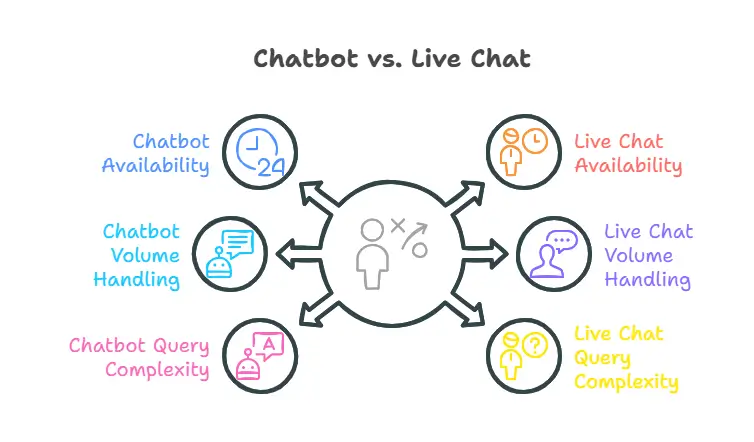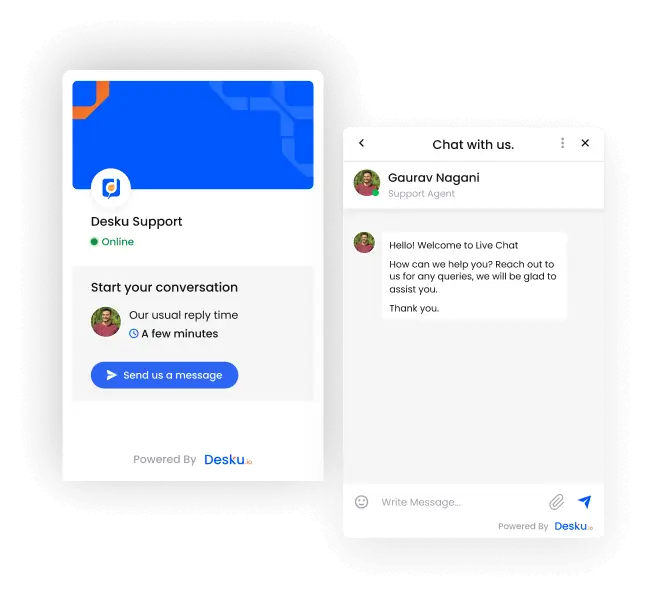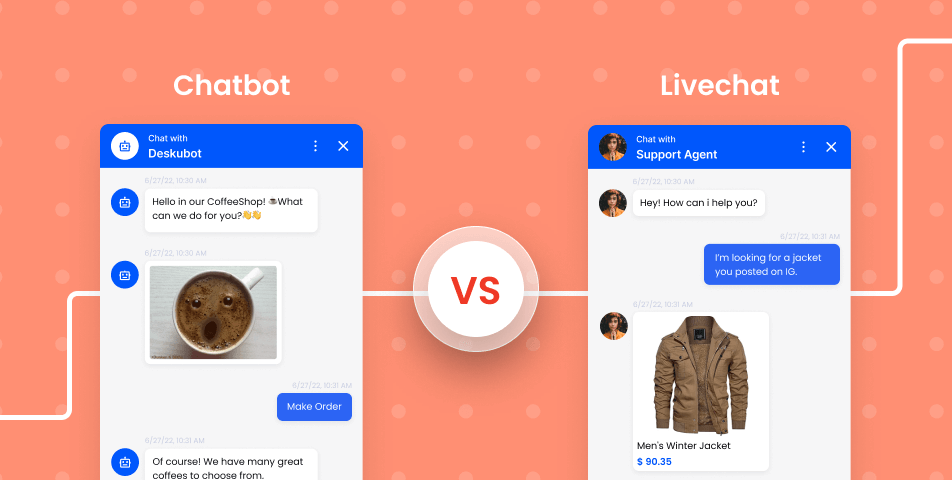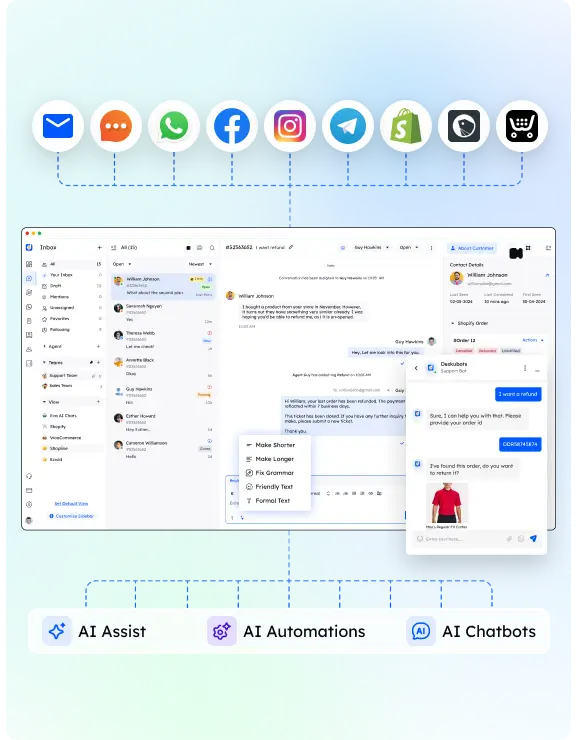Customer expectations have never been higher. Whether a customer reaches out during business hours or late at night, they expect instant responses and seamless service. That’s where chatbots and live chat come in. Both options can handle customer inquiries and provide immediate assistance, but each has unique strengths. Chatbots leverage machine learning and natural language processing to deliver automated responses, making them ideal for repetitive customer inquiries. On the other hand, live chat agents offer the human touch and personalized responses, which are vital for addressing complex customer issues.
This article dives into the key differences between these two tools. By the end, you’ll know how to choose the best solution—or combination—for your customer support team to improve customer engagement, reduce customer service costs, and boost your overall customer experience.
What Are Chatbots?
Chatbots are automated tools powered by artificial intelligence and machine learning. They’re designed to handle repetitive customer inquiries and provide immediate answers through chat widgets, mobile apps, or even platforms like Facebook Messenger. Using natural language processing, chatbots can simulate human conversation, offering instant responses to customer queries.
- Key Advantages of Chatbots:
- 24/7 availability for website visitors, even outside business hours.
- Ability to handle multiple conversations simultaneously without fatigue.
- Cost-effective, reducing reliance on large customer support teams.
- Perfect for resolving support tickets related to simple issues like password resets or order tracking.
However, chatbots have their limits. They may struggle with complex questions or situations that require human interaction and personalized support. This is where live chat comes into play.
What Is Live Chat?
Live chat software connects customers to live support agents in real-time. These human agents excel at resolving complex customer issues and delivering a personalized customer experience that automated tools can’t match. Live chat is typically accessible via a live chat widget on a website or app, making it easy for customers to reach out for help.
- Key Advantages of Live Chat:
- Provides the human touch needed for nuanced situations or emotional support.
- Tailored, personalized responses to customer needs.
- Supports complex queries that require in-depth problem-solving.
- Builds trust and customer loyalty by fostering genuine customer interactions.
Despite its strengths, live chat does have limitations. Its reliance on live agents means it is constrained by business hours unless your company employs a global or around-the-clock customer support team. Additionally, it may increase customer service costs, especially during peak times when more support agents are required.
Chatbot vs. Live Chat: Key Differences

Choosing between chatbots and live chat depends on understanding their unique capabilities and how they align with your customer-centric business goals. Here’s a breakdown of the key differences to help your decision-making.
1. Availability and Response Time
- Chatbots: Operate 24/7, providing immediate responses to customer queries, even outside normal business hours. This ensures that customers don’t have to wait, enhancing customer satisfaction.
- Live Chat: While live chat offers immediate assistance during active hours, its availability depends on the working hours of your support agents. Delays may occur if customers wait during high-traffic periods or off-hours.
2. Handling Volume
- Chatbots: Capable of handling multiple conversations simultaneously, making them ideal for website visitors with common inquiries. For instance, chatbots can resolve hundreds of support tickets related to repetitive questions like shipping details or FAQs.
- Live Chat: Live chat agents manage a limited number of conversations at once. During peak times, customers might experience slower responses as support agents balance several inquiries.
3. Complexity of Customer Queries
- Chatbots: Best suited for repetitive customer inquiries or tasks like providing canned responses and guiding users through simple processes. However, they often struggle with complex questions or complex customer issues requiring deeper understanding.
- Live Chat: Human agents excel in addressing complex queries and delivering personalized responses that require human intervention. They can also provide empathetic support for sensitive issues, enhancing the customer experience.
4. Cost and Scalability
- Chatbots: Offer a cost-effective solution by reducing reliance on a large customer support team. They are particularly useful for scaling support without a significant increase in customer service costs.
- Live Chat: While highly effective, employing a team of live agents can be expensive, especially for small businesses. Scaling up during high demand often requires additional resources.
5. Customer Engagement and Satisfaction
- Chatbots: Provide quick, instant answers, and are ideal for multiple conversations or answering straightforward customer inquiries. However, they might lack the human touch that drives deeper customer engagement.
- Live Chat: Builds stronger connections through human conversation, boosting customer loyalty. Personalized service from live support agents often leaves customers feeling more valued, leading to better overall customer satisfaction.
6. Integration and Technology
- Chatbots: Easily integrate with customer relationship management (CRM) systems and other tools, making them a seamless addition to existing workflows. Many use advanced technologies like artificial intelligence and machine learning for ongoing improvement.
- Live Chat: Relies on live chat software that requires consistent updates and integration with platforms like mobile apps or chat support systems. While slightly more resource-intensive, live chat often delivers a richer experience when set up correctly.
How to Choose: Chatbots, Live Chat, or Both?

For many businesses, the choice between chatbots and live chat solutions boils down to their specific needs, resources, and goals. Here’s a framework to help you decide:
When to Use Chatbots
Chatbots are a great fit for businesses that prioritize efficiency, scalability, and cost reduction. Consider using chatbots if:
- You frequently deal with repetitive customer inquiries or support tickets like order tracking, FAQs, or payment status updates.
- Your customers need instant answers around the clock, even outside of business hours.
- You want to reduce customer service costs while maintaining immediate assistance for basic tasks.
- Your support strategy includes platforms like Facebook Messenger, mobile apps, or chat widgets, where customers expect quick replies.
Example Use Cases for Chatbots:
- E-commerce stores answering product availability questions.
- SaaS companies offering onboarding tips through automated guides.
- SMEs resolving account or subscription queries without human involvement.
When to Use Live Chat
Live chat is ideal for businesses that prioritize personalization and complex problem-solving. Use live chat if:
- Your customer base values human interaction and prefers the human touch for resolving complex customer issues.
- You aim to enhance customer engagement through personalized responses.
- Your industry involves high-value or sensitive customer interactions, such as insurance claims, legal advice, or high-ticket sales.
- You want to improve response time while handling customer inquiries during business hours.
Example Use Cases for Live Chat:
- Customer service teams solving billing disputes or troubleshooting technical problems.
- E-commerce businesses offering real-time advice on product recommendations.
- SMBs handling detailed inquiries that require back-and-forth human conversation.
When to Use Both
Combining chatbots and live chat creates a hybrid model, offering the best of both worlds. This approach is particularly useful if you want to maximize efficiency without sacrificing customer satisfaction. A chatbot can handle the initial customer communication, routing complex queries or customer issues to live support agents when necessary.
Benefits of a Combined Approach:
- Faster response times for all inquiries.
- Reduced workload for your customer support team, letting them focus on high-value tasks.
- Enhanced customer experience by blending the speed of automation with the empathy of human agents.
Example Hybrid Model:
- Chatbot handles pre-qualification by gathering details about the inquiry. If the issue is complex, it escalates the customer to a live agent.
- Live chat takes over high-priority support tickets, leaving routine questions to the chatbot.
Conclusion: Finding the Right Balance for Your Business
The debate between chatbots and live chat isn’t about choosing one over the other. It’s about understanding their roles in meeting customer expectations and crafting a strategy that enhances customer satisfaction while managing customer service costs.
- Chatbots are ideal for automating repetitive tasks, providing instant responses, and ensuring 24/7 availability. They shine in handling high volumes of customer inquiries and support tickets with precision and speed.
- Live chat, on the other hand, is unmatched when it comes to solving complex customer issues and delivering a personalized customer experience through human interaction.
For many businesses, the smartest choice is a hybrid model, leveraging both tools to balance cost-efficiency and exceptional customer engagement. By combining the strengths of chatbots and live support agents, you can address a broader spectrum of needs, leaving customers feeling valued and supported.
FAQ: Common Questions About Chatbots and Live Chat
1. Can chatbots replace live chat entirely?
Not completely. While chatbots are excellent for instant responses and managing repetitive customer inquiries, they lack the human touch and empathy needed to address complex customer issues. A hybrid approach often works best, combining automation with human agents for a well-rounded customer support team.
2. Are chatbots more cost-effective than live chat?
Yes, chatbots typically reduce customer service costs by automating tasks and requiring fewer live agents. They can operate 24/7 without additional expenses for staffing, making them an excellent choice for scaling support.
3. How do chatbots handle complex queries?
Chatbots use machine learning and natural language processing to understand and respond to queries. However, they may struggle with complex questions or issues requiring human intervention. In these cases, a chatbot can escalate the query to a live chat agent.
4. Can live chat agents handle multiple conversations at once?
Yes, live chat agents can manage multiple conversations, but their capacity is limited compared to chatbots. A well-trained agent might handle 3-5 chats simultaneously, depending on the complexity of the inquiries.
5. Do chatbots and live chat integrate with CRM systems?
Both tools can integrate seamlessly with customer relationship management (CRM) platforms. Chatbots often update customer records automatically, while live chat agents can add personalized insights to enhance the customer relationship.
6. How can businesses measure the success of chatbots and live chat?
Key performance metrics include:
Response time: How quickly customers receive help.
Customer satisfaction: Feedback collected after interactions.
Resolution rate: The percentage of queries resolved successfully.
Cost per conversation: Comparing the expenses of chatbot vs. live agent support.


